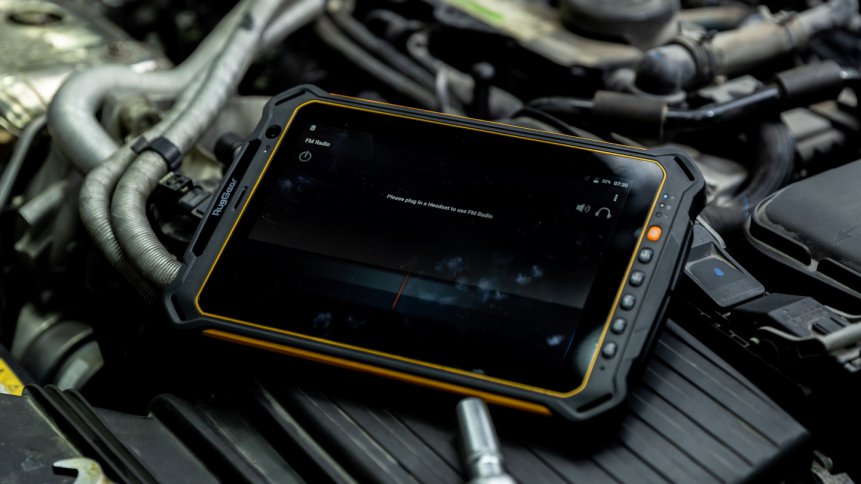Ruggedized PC’s: what does it take to keep processors whirring when things get tough?

Not all computers enjoy the comfort of a modern office or an air-conditioned control room. Some machines must withstand being dropped, shaken, and being outdoors exposed to a variety of dusty, humid, wet, cold, and hot conditions. For most of us, the biggest physical threat to the well-being of our work laptops is a knocked-over cup of coffee or glass of water that gives the keyboard an unintentional soaking. But ruggedized PCs have a much harder life in the field where being bumped around and rained on comes with the territory, and products must serve their users wherever their work takes them.
So how do manufacturers go about protecting their machines so that ambulance crews, police officers, military personnel, field engineers, and others can rely on them when the going gets tough?
Let’s start with water. Regular keyboards have a thin membrane covering the PCB underneath, but this offers little moisture protection longer term – for example, against high-humidity or persistently damp conditions. Water-resistant versions have circuits that are more enclosed and can feature drainage channels, but better still are fully waterproof configurations, which include silicone designs. These also protect against dust and dirt and are easy to clean, although they may feel harder to type on than a regular keyboard.
Users of 2-in-1 designs, have the option of detaching the keyboard portion, stowing it away, and simply using the device as a tablet, which is one sure-fire way of stopping rain from ruining the keyboard! Tough ruggedized tablets designed for industrial use have been a big hit across aerospace, healthcare, oil & gas, and manufacturing sectors (to name just a few) replacing laptops as the go-to computing device. And this trend looks to continue into 2023, according to market data.
Tablets have proven to be a popular form factor since the introduction of the iPad in 2010, so it’s easy to see why ruggedized models would also be a big hit for industrial applications. But they, like the laptops they are increasingly replacing, have ports that are vulnerable to getting wet.
Connector concerns
One option to cover off any liquid ingress through USB connections, charging sockets, SD card readers, network ports and other interfaces, is to seal them up with removable moulded inserts dubbed port plugs. Again, this strategy will also help keep out any neighbouring dust and dirt. Fully ruggedized laptop designs often go a step further with miniature doors built into the chassis that are only opened when needed and otherwise provide a trustworthy defence against all weathers.
Ruggedized laptops may have lost some ground to tough tablets, but there are applications where they still come into their own such as the quick deployment of mobile servers. Users may need to use the device in conjunction with other sensors – for example, optical programmers or antennas for querying meter data, which points back to a laptop as a likely first choice.
Butter side up
Much like if you have the misfortune to drop your toast in the morning, you’d like your tumbling laptop (or tablet) to land safely so that all’s needed is a quick dust down; leaving you all set to carry on as you were. Ruggedized PC makers stack the odds in their favour by adding bumpers and impact forgiving chassis to their products. Materials at their disposal can include exotic options such as durable automotive grade aluminum-magnesium alloys – as favoured by US military supplier Durabook and other laptop makers. In its product literature, Durabook quotes ‘6 foot drop survivability’.
For tablets and phones, the testing of bump cases has become a youtube hit with manufacturers throwing smart devices wearing their designs out of helicopters to attract customers. The surprise on their faces when the electronics bounce back unscathed doesn’t inspire full confidence, but the results are impressive nonetheless.
Tough-testing protocol
A useful standard to be aware of is MIL-STD 810G, which provides a thorough workout for any device brave enough to apply for duty. Laptop maker ASUS gives a good summary, noting that the prescribed tests feature extremes of altitude, temperature, and humidity, along with physical vibration and shocks designed to mimic rough day-to-day handling. And, according to its website, Lenovo puts its ThinkPad products through 12 methods and 20 procedures, which include two hours of shipboard vibration and 28 days of exposure to common fungus sources. Tests against salt, fog and sand-dust also form part of the military-grade protocol.
While reaping the benefits, customers will ultimately end up paying for the cost of this extra testing. And there are other penalties. Bumpers and impact-resistant materials add weight, with some laptops even featuring built-in handles to make it easier for users to carry the product around. But this goes with the territory and there’s much to celebrate with the list of features on offer, which includes swappable batteries – a feature that is often sorely missed in mainstream devices.










